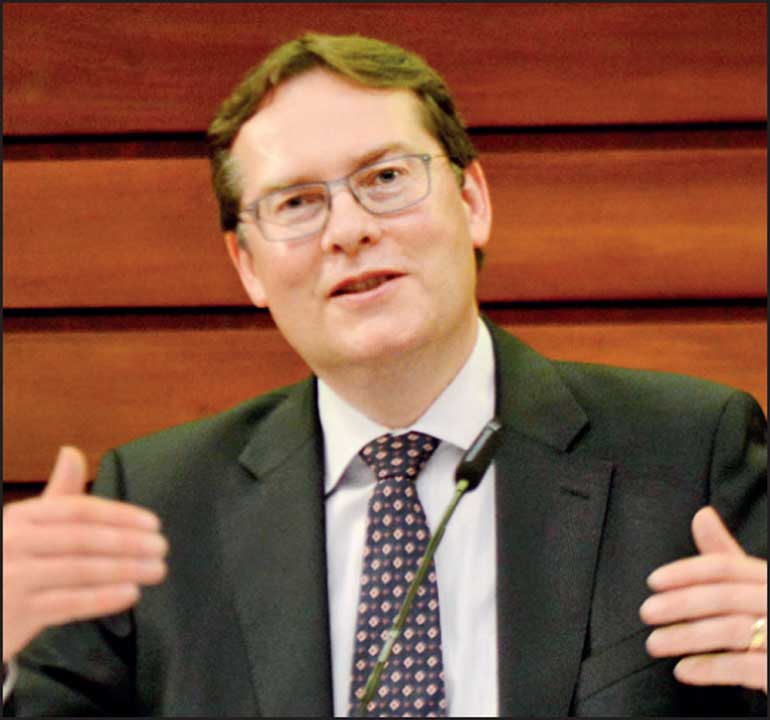Tuesday Apr 08, 2025
Tuesday Apr 08, 2025
Wednesday, 17 May 2023 00:00 - - {{hitsCtrl.values.hits}}

IMF Senior Mission Chief for Sri Lanka Peter Breuer gestures during the media briefing on Monday – Pic by Pradeep Pathirana
By Nisthar Cassim
The International Monetary Fund (IMF) on Monday said it was encouraging Sri Lanka to finalise its strategy on domestic debt thereby resolving the uncertainty and resultant upward pressure on interest rates.
“We have taken note of this uncertainty that has elevated interest rates in the country. We are encouraging the authorities to come up with a strategy soon so that this uncertainty can be resolved, the interest rates can come down and this can be part of a virtuous cycle to restore stability,” said IMF Senior Mission Chief for Sri Lanka Peter Breuer told a media briefing on Monday along with IMF Director of Asia and Pacific Department Krishna Srinivasan.
The duo stressed that whilst the IMF has determined that Sri Lanka’s debt level is unsustainable it doesn’t get involved in the restructuring. “Our role is to ensure that whatever debt restructuring strategy the authorities decide on is consistent with the IMF program,” Breuer said.
Noting that the debt targets set in the IMF’s $ 3 billion four year Extended Fund Facility (EFF) program are designed for Sri Lanka to restore debt sustainability. “We don’t have any particular view on how the burden should be distributed across creditors, whether they’re external or domestic. Having said that, we do have a keen interest to ensure that the domestic economy and the financial stability financial system continue to work and are stable. So those are the aspects that we would focus on in the discussion,” said Breuer.
He is in Sri Lanka along with other officials as part of regular consultations ahead of the first review mission in September under the IMF program. Sri Lanka’s debt is at a record high of 128% of GDP and the IMF program envisages it to be reduced to 106.8% by 2026
Breuer stressed that it was up to the authorities to decide how to distribute the burden of debt relief across different creditors.
IMF noted that the Sri Lankan authorities are engaged in their surveillance exercise over the financial system to look at the quality of the assets that the banks have and what implications this has in terms of capitalisation levels.
IMF said it draws comfort from what it has seen so far in terms of financial sector stability in Sri Lanka at present.
The Central Bank has proposed Domestic Debt Optimisation (DDO) over which the local banks have sought clarity.
Sri Lanka Banks Association (Guarantee) Ltd. (SLBA) said recently it is relieved to note that the Central Bank of Sri Lanka (CBSL) has assured banks that the regulatory stance in the on-going DDO discussions with the diverse stakeholders will be that the banking sector stability cannot be put at risk.
SLBA said the capital and liquidity of the banks need to be maintained sufficient to support the growth of the economy post-debt restructuring, together with other necessary measures to bring the balance of payments and fiscal deficit into a sensible equilibrium. Presently the banking sector is well capitalised with average Capital Adequacy Ratio over 15% and a Liquidity Coverage Ratio of 200%. The imperative remains to be that this position is not weakened.
SLBA said the challenges that the economy and the banking system could face in the period ahead if the envisaged Balance of Payments and Fiscal Reforms are delayed or derailed are significant for the economy and the banks. “We therefore take comfort from CBSL’s assurance,” it added.
Earlier this week Opposition MP Harsha de Silva warned against the potential risks of DDO, stressing the need for extreme caution.
He cautioned that if not managed carefully, domestic debt optimisation could become a burden rather than a relief for the economy.
Citing the net debt relief Laffer curve, de Silva stated that the more we increase the haircut on banks, the more likely we are to hit the curve’s negative impact zone, where debt restructuring becomes counterproductive, thus leading to a negative impact on the economy. Harsha provided another example of this phenomenon: taxes on wine and spirits. High taxation has resulted in a drop in consumption, which, in turn, has substantially reduced the expected revenue for the Excise Department. Therefore, de Silva emphasised that the risk of capital adequacy in banks could result from debt optimisation, which is when a bank’s capital falls below the recommended levels, raising questions about its stability.
The SJB MP emphasised the need for discussions on this complex issue to occur in the Committee on Public Finance. By summoning relevant officials and utilising data to work the numbers, the committee could help avoid potential blame down the road.
Furthermore, he proposed the establishment of a Financial Sector Support Fund to ensure macro-stability. He suggested that multilateral organisations like the World Bank and ADB would lend money to establish this fund, as over $1 billion would be needed.